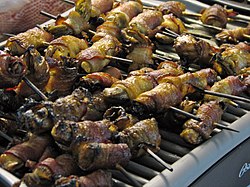Angels on horseback

Angels on horseback skewered and grilled.
|
|
| Course | Canapé, hors d'œuvre or savoury |
|---|---|
| Serving temperature | Hot |
| Main ingredients | Oysters, bacon |
| 160~ kcal | |
| |
|
Angels on horseback is a hot hors d'œuvre or savoury made of oysters wrapped with bacon. The dish, when served atop breads, can also be a canapé.
The dish is typically prepared by rolling shucked oysters in bacon and baking them in an oven. Modern variations of angels on horseback include skewering and frying. Serving can vary widely to taste on either skewers or breads, with additional accompaniments or condiments. Angels on horseback differ from the similar, fruit-based, devils on horseback, but the dishes' names are sometimes erroneously considered synonyms.
Angels on horseback can be served a hors d'œuvre, as a canapé, or as a savoury. Angels on horseback are canapés when served with breads. In England, savouries are served after the dessert and are salty or savoury items meant to cleanse the palate before the serving of wines. One cookbook including angels on horseback as a savoury is the 1905 Savouries Simplified, by Constance Peel.
Angels on horseback should not be confused with devils on horseback. The latter dish, which is derived from the former, uses fruit, typically prunes or dates. American and British chefs including Martha Stewart and Martin Blunos recognise the distinction between the dishes, and though food writer John Ayto does too, he notes that the names have often been used interchangeably. This has been traced to a Chicago Tribune article and James Beard who "insisted that angels on horseback required ham as a wrapper, and that if bacon were used, what you'd have would be devils on horseback."
The origins of the dish are unclear. The name most likely derives from the French anges à cheval, and there appears to be no significance in the oyster/angel and bacon/horse links. Its first occurrence, according to the Oxford English Dictionary and other sources, is in 1888, in Mrs Beeton's Book of Household Management. However, there is a reference in an Australian newspaper to the dish, which includes a brief recipe, from 1882.
...
Wikipedia
